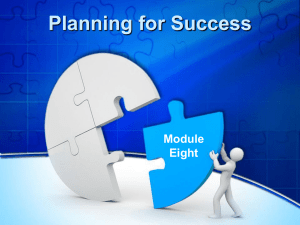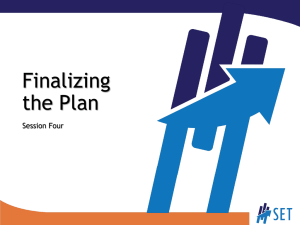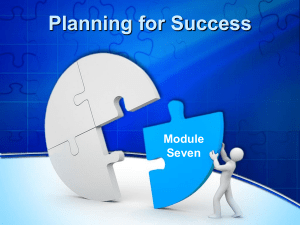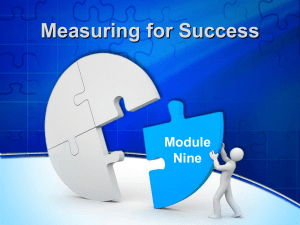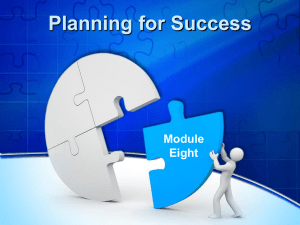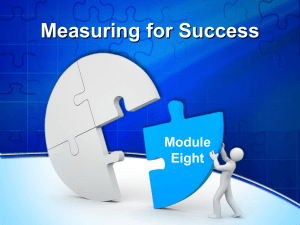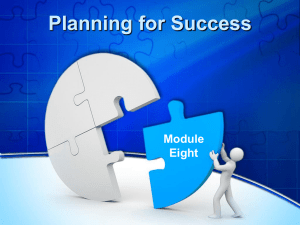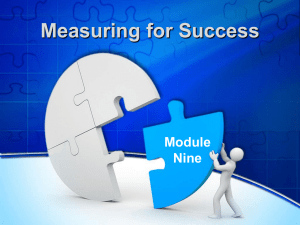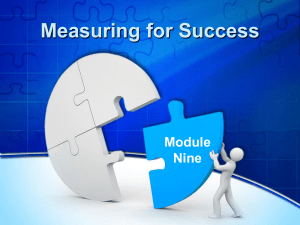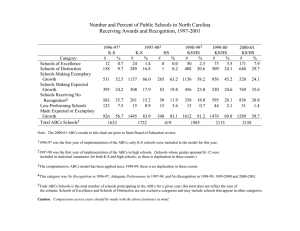Conditions
advertisement
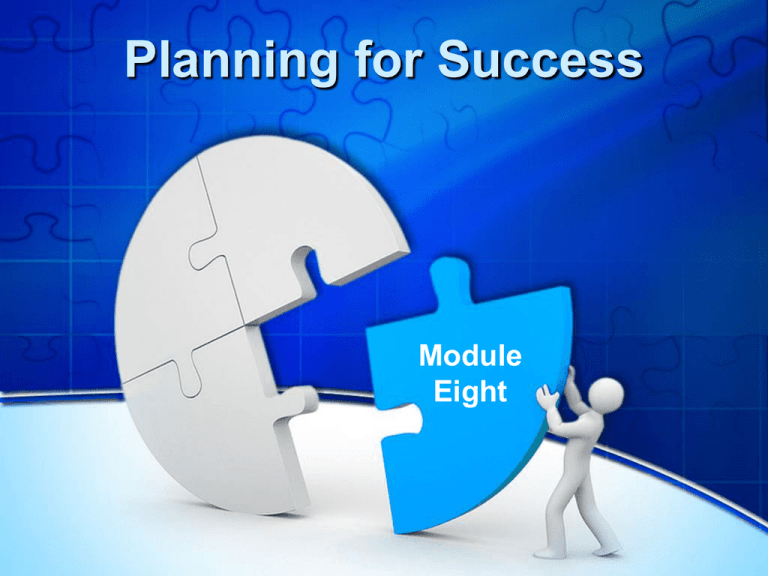
Planning for Success Module Eight Reflecting on the Previous Session • What was most useful from the previous session? • What progress have you made since then? • Any other comments or questions about that session? Session Overview • Defining the Regional Goal(s) • Identifying the ABCs of Success • Selecting Strategies • Planning for Action Defining the Goal: Getting on the Same Path Considering Potential Goals • Any ideas missing? • Don’t get bogged down in detail. • Consensus is not necessary yet. The Climate: Elements to Consider Regional data Past history & strategies Economic strength Regional Goals Regional assets Potential barriers Evaluating a Potential Goal Economic Strength: Strong core of small successful businesses Regional Data: Growing number of small businesses Past Strategies: Business incubator successfully piloted in 1 county Establish an Entrepreneurship Support Network Regional Assets: Sm. Bus. Development Center, community college, Extension Potential Barriers: Identifying existing resources Writing SMART Goals Identifying the ABCs of Successful Planning Making Changes that Matter Do You Know Your ABCs? Attitudes, Knowledge, and Skills Behavior Conditions Success Moving Forward: Start with the End in Mind Successful planning means thinking with the end product in mind. Success Condition Conditions are the overarching changes you hope to see as a result of your efforts. Changes in conditions take the longest to achieve. Typically 5 years or more Examples of Regional Conditions • Reducing unemployment rate • Reducing poverty rate • Improving high school graduation rate • Expanding number of profitable entrepreneurs • Increasing number of jobs paying good, livable wages • Increasing regional revenue generated from tourism Your Plan: Start with the End in Mind Imagine five years from now…. • What do you hope is different in your region? • What condition do you hope to change? Conditions Success Behaviors Behaviors are concrete actions that individuals or groups take. Conditions change as a result of changed behavior by individuals or groups. These require doing something. Typically 1-2 years Moving from B to C Behavior • Individuals may need to work toward finishing high school • Businesses may need to develop Web sites • Government may need to expand support services to existing businesses Condition To: Increase graduation rates To: Increase the number of successful small enterprises To: Retain and expand existing businesses Your Plan: Go back to the condition you identified. What behaviors need to change to reach that condition? Who needs to make those changes? Behavior Conditions Success Attitudes, Knowledge and Skills Attitudes, knowledge and skills are elements individuals or groups can learn or develop in a rather short time. These require “brain power” or new learning. Typically within the first 6-12 months Moving from A to B Attitude/Knowledge/Skill • A person may need to value a high school diploma (attitude) • A business may need to learn how to create a Web site (skill) • Government may need to learn about concerns facing existing businesses (knowledge) Behavior To: Work toward finishing high school (behavior) To: Develop a Web presence To: Expand appropriate support services Your Plan In order to get to the behaviors you want to change, what attitudes, skills or knowledge need to change? Attitudes, Knowledge, and Skills Behavior Conditions Success Selecting Strategies Strategies: What We Do Our Regional Team Does Things • Workshops • Counseling • Technical Assist. • Materials To/for/ with People • Clients • Stakeholders • Partners • Businesses ABCs Strategies: Key Questions Which ones will: • Come closest to producing the desired outcomes (ABCs)? • Appeal most to your target audience? • Make the best uses of resources and assets? • Help overcome key barriers? Connecting the Pieces Should Tell a Logical Story Strategy Attitudes, Knowledge, and Skills Behavior Conditions Success Example Should Tell a Logical Story Strategy Attitudes, Knowledge, and Skills Behavior Conditions Web training & tech assist. Participants learn the value of Web site Participants build Web site Participants see increased revenue Success Stronger Small Business Base Your Plan: Checking the Story • Does your strategy match your ABCs? • A logical story should move from your strategy, through your ABCs, to the success you anticipate. Assets: The Engine Individuals, organizations and resources you will need to implement your strategy Your Plan: Assets • Identify your assets: What organizations are contributing? What individuals are contributing? • Are there missing pieces? If so, who can help with these? Planning for Action Developing a Plan of Action Four Key Elements: • Specific steps to be carried out • Person who will take leadership for each step • Realistic timetable for completion of each step • Regular checkpoints to ensure progress & address barriers Your Plan: Gearing Up for Action Final Reflections Takeaways from this module? • • • • What did you find most helpful? What did you find confusing? What do you hope to implement? Other items? Homework For each regional goal, complete a: • Planning Chart • Plan of Action These will form the foundation for the final module, Measuring for Success. Looking Ahead: Module Nine • • • • • Exploring the Value of Measuring Deciding What to Measure Using Measures to Promote Success Tracking Appropriate Measures Creating a Regional Plan for Measuring Success
